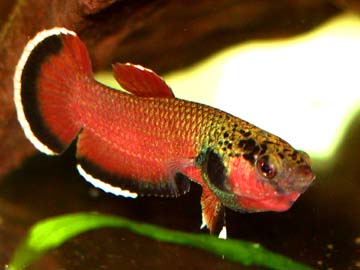Betta Channoides (Snakehead Betta)

Photo by Kei Sasaki
Dive into the world of Betta channoides, a captivating species that brings a piece of the wild into your aquarium. This post is designed to better understand their needs, behavior, and how to mimic their natural environment for a thriving life in captivity.
Channoides Betta Quick Overview
Click here to see my favorite, simplified, betta fish care guide…
Betta channoides, often hailed as the “Snakehead betta” due to its distinctively large mouth and head shape reminiscent of the Channa species, is a small yet vibrant addition to the freshwater aquarium. Originating from the blackwater streams of Borneo’s eastern province, specifically the Mahakam river basin, this species is prized for its bright orange coloration in males, peaceful temperament, and intriguing mouthbrooding breeding behavior.
Betta channoides in the Wild
These fish inhabit shallow pools and streams with very low pH levels, often between 3-4, caused by decaying leaf litter that tints the water a tea-like brown. The low vegetation but abundant organic material like branches and leaves offers cover, defining these habitats as blackwater environments.
Appearance
Reaching up to 2 inches, males are distinguished by their intense orange body and black fins with white borders. The significant mouth size, developed for mouthbrooding, alongside their dorsal fin’s red-orange color with a white border, sets them apart from similar species like Betta albimarginata, which has darker, often fully black dorsal fins.
The Channoides betta earned the nickname “snakehead betta” due to its physical resemblance to fishes in the Channa genus, commonly known as snakeheads. Here’s why:
- Head Shape: Both the Channoides betta and snakehead fishes share a similar elongated, slightly flattened head profile.
- Mouth Size: The Channoides betta has a noticeably larger mouth than many other betta species. This trait is also common in snakehead fish.
Temperament
Betta channoides stands out for its peaceful nature, allowing for cohabitation in pairs or small groups without severe aggression. However, establishing territories is crucial in a community tank, especially with multiple males, to minimize conflict. Unlike Betta splendens, they do not typically flare or attack on sight, but males may defend territories or compete for dominance.
Betta channoides Care
Fish Tank Setup:
- Size: A minimum of 10 gallons for a pair, with 15 gallons suitable for a trio and 20 gallons for a small group.
- Planting: While their natural habitat isn’t heavily planted, in captivity, plants like Java moss, fern, frogbit, and Anubias provide necessary cover and mimic their environment. Indian almond leaves are essential for simulating the leaf litter floor, offering shelter and releasing beneficial tannins.
- Water Flow: A gentle water flow mimics their habitat’s currents, beneficial for mouthbrooders. However, ensure the flow is not too strong to avoid exhausting the fish. While filters aid in water cleanliness, they’re not mandatory with diligent water changes.
Tank Mates:
Suitable for peaceful and small species that won’t compete aggressively for food or territory. Shrimp, Corydoras, Kuhli loaches, and Norman’s Lampeye Killis are excellent companions in appropriately sized and well-structured tanks.
Food:
Emphasize a carnivorous diet with a variety of live, frozen, and high-quality dried foods to cater to their predatory nature. Diversity in diet ensures they receive all necessary nutrients.
Water Parameters:
Adaptable to a range of conditions but thrives in soft, acidic water reminiscent of their blackwater origins. Regular water changes and the addition of Indian almond leaves help maintain the desired water chemistry.
Breeding Betta Channoides
Breeding these paternal mouthbrooders involves creating a stress-free environment with softened, acidic water and higher temperatures for spawning. Small batches of 5-12 large eggs are typical, with males brooding for 2-3 weeks. Post-spawn care includes minimizing stress for the male and ensuring the fry have appropriate food and shelter to grow.
Spawning Process:
Pairs should form naturally within a group or be selected for a breeding setup. Spawning triggers include comfortable conditions, pH adjustments, and temperature increases.
Raising Fry:
After males release independent fry, removing parents prevents accidental predation. Early feeding should include baby brine shrimp, transitioning to chopped live or frozen foods as they grow. Tannin-rich environments from added leaves boost fry resilience and survival rates.
Products You Need for Wild Bettas
A curated selection of products will be listed to support the specific needs of Betta channoides, from adjustable heaters and gentle filters to specialized foods and Indian almond leaves. These tools are essential for recreating their natural conditions and promoting their well-being in captivity.
Conclusion
Betta channoides offers a unique glimpse into the diverse world of bettas, with their distinctive breeding behavior, peaceful cohabitation potential, and specific care requirements. By closely replicating their natural habitat and understanding their needs, enthusiasts can enjoy the rewarding experience of keeping these fascinating fish. Share your journey and learn from the community as we explore the beauty and complexity of Betta channoides together.


